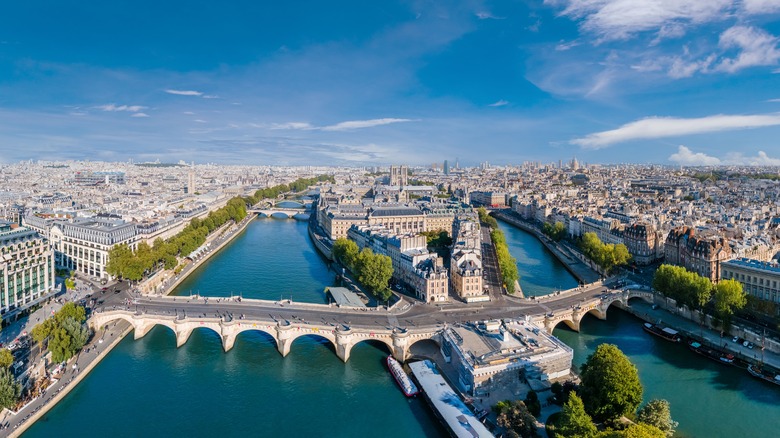This Island Is Paris' Historic Birthplace And Boasts Postcard-Worthy Destinations
The history of Paris often makes people think of opulent royal lifestyles, empirical conquests, or cabaret nightlife. However, Paris dates back much further than the eras which coincide with such associations. What is now a sprawling city began with the Parisii Celtic tribe around 200 B.C. on an island in the Seine River. Today, this island is called Île de la Cité, and it still features major destinations in Paris that everyone needs to see while also being important to modern French government.
Likely the biggest draw for Île de la Cité is the iconic Notre-Dame Cathedral. Even if you only have one day in Paris, Notre-Dame is a must visit. Construction on this landmark first began in the 1100s and took hundreds of years to build. While a fire in 2019 shocked and saddened people all over the world, this 800-year-old structure is still standing. It is still closed to the public due to ongoing reconstruction at the time of this writing, but its massive façade and flying buttresses still make Notre-Dame a sight to behold even from the outside. It is a prime example of both Gothic and Romanesque architecture and major publications like Architectural Digest still consider the Notre-Dame's stained glass windows to be some of the best in the world.
See even more stained glass at Sainte-Chapelle
Just across from the square in front of Notre-Dame's entrance is the Archaeological Crypt of the Île de la Cité (Crypte Archéologique de l'İle de la Cité). The artifacts on display here began with archaeological excavations from 1965 to 1970. A visit to this crypt showcases 2,000 years of Parisian history from remains of bathhouses when the area was a Gallo-Roman city to the centuries of changes in Paris's urban planning, including the modern advances ushered in by Baron Haussmann in the 19th century.
Another place to see world-renowned stained glass on Île de la Cité is Sainte-Chapelle. In fact, this chapel is practically more stained glass than it is stone. It dates back to the reign of King Louis IX in the 1200s and is believed to house relics of Jesus Christ's Crown of Thorns. Sainte-Chapelle also features incredibly detailed sculptures of the apostles and various plants and animals to further decorate this otherworldly icon of Paris. If you cannot enter the Notre-Dame Cathedral, you will not feel that you have missed out on any opulence if you visit Sainte-Chapelle. Buy tickets online in advance to choose a time slot for your visit.
Visit landmarks of the French Revolution like Conciergerie
Right next to Sainte-Chapelle is Palais de Justice de Paris. Though this is still a working courthouse, it is open to the public. Like Notre-Dame, Palais de Justice has endured fires, this time in the 17th and 18th centuries, as well as a siege during the French Revolution. The courthouse's massive Hall of Lost Causes (Salle des Pas Perdus) is a highlight of this building and evokes an atmosphere of both royalty and powerful government, especially when thinking of how long France has been a significant country in international relations.
Head toward the Pont au Change Bridge to see the Conciergerie, another icon of the French Revolution. This structure along with Sainte-Chapelle and Palais de Justice de Paris were the components of Paris's first royal residence. However, it is perhaps most known for its conversion into a prison during the French Revolution. The revolutionaries imprisoned Queen Marie Antoinette here before she and her husband King Louis XVI were both beheaded at the end of the 18th century. Despite the tumult, Conciergerie remains a beautiful building with medieval vaulted ceilings and dark gray-capped towers that stand out along the Seine River. Visit for free or buy a ticket for a guided tour. There are also combination tickets with Sainte-Chapelle to visit both at a discount.
Stop at the postcard-worthy Au Vieux Paris d'Arcole
Allow yourself to get lost on Île de la Cité as the entire island is easily walkable and not just filled with major landmarks. Among the smaller destinations on Île de la Cité is the fairytale-like Au Vieux Paris d'Arcole just around the corner from Notre-Dame. You'll quickly see why this building is so often photographed. Its mint-green façade, cottage décor, wisteria, and crawling vines are like something out of a movie. Au Vieux Paris d'Arcole is actually a restaurant housed in a 16th-century building. It serves traditional French dishes and has its own wine cellar.
As you either arrive to Île de la Cité or depart, consider doing so via Pont Neuf. While there are plenty of famous bridges in Paris like Pont des Arts and Pont Alexandre III, Pont Neuf is the oldest bridge in the City of Lights. It dates back to 1607 and King Henry III placed the first stone. Aside from being important to Paris's engineering history, this bridge offers a perfect view of the Conciergerie.



